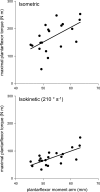Plantar flexor moment arm and muscle volume predict torque-generating capacity in young men
- PMID: 24371016
- PMCID: PMC3949211
- DOI: 10.1152/japplphysiol.01140.2013
Plantar flexor moment arm and muscle volume predict torque-generating capacity in young men
Abstract
Muscle volume is known to correlate with maximal joint torque in humans, but the role of muscle moment arm in determining maximal torque is less clear. Moderate correlations have been reported between maximal isometric knee extensor torque and knee extensor moment arm, but no such observations have been made for the ankle joint. It has been suggested that smaller muscle moment arms may enhance force generation at high rates of joint rotation, but this has not yet been observed for ankle muscles in vivo. The purpose of the present study was to correlate plantar flexor moment arm and plantar flexor muscle volume with maximal plantar flexor torque measured at different rates of plantar flexion. Magnetic resonance imaging was used to quantify the plantar flexor moment arm and muscle volume of the posterior compartment in 20 healthy young men. Maximal plantar flexor torque was measured isometrically and at three plantar flexion speeds using an isokinetic dynamometer. Plantar flexor torque was significantly correlated with muscle volume (0.222 < R(2) < 0.322) and with muscle moment arm at each speed (0.323 < R(2) < 0.494). While muscle volume was strongly correlated with body mass and stature, moment arm was not. The slope of the torque-moment arm regression line decreased as the rate of joint rotation increased, indicating that subjects with small moment arms experienced smaller reductions in torque at high speeds. The findings of this study suggest that plantar flexor moment arm is a determinant of joint strength that is at least as important as muscle size.
Keywords: force-velocity; joint torque; moment arm; plantar flexors.
Figures





Similar articles
-
Neuromechanical properties of the triceps surae in young and older adults.Exp Gerontol. 2013 Nov;48(11):1147-55. doi: 10.1016/j.exger.2013.07.007. Epub 2013 Jul 22. Exp Gerontol. 2013. PMID: 23886750
-
Isometric contractions reduce plantar flexor moment, Achilles tendon stiffness, and neuromuscular activity but remove the subsequent effects of stretch.J Appl Physiol (1985). 2009 Oct;107(4):1181-9. doi: 10.1152/japplphysiol.00281.2009. Epub 2009 Jul 30. J Appl Physiol (1985). 2009. PMID: 19644033 Clinical Trial.
-
Contributions to the understanding of gait control.Dan Med J. 2014 Apr;61(4):B4823. Dan Med J. 2014. PMID: 24814597 Review.
-
Effects of knee joint position on the triceps Suræ torque-size relationship during plantarflexion in healthy young adults.J Biomech. 2024 Dec;177:112436. doi: 10.1016/j.jbiomech.2024.112436. Epub 2024 Nov 19. J Biomech. 2024. PMID: 39577118
-
Imaging-based estimates of moment arm length in intact human muscle-tendons.Eur J Appl Physiol. 2004 Mar;91(2-3):130-9. doi: 10.1007/s00421-003-1033-x. Epub 2003 Dec 18. Eur J Appl Physiol. 2004. PMID: 14685871 Review.
Cited by
-
Ankle Rotation and Muscle Loading Effects on the Calcaneal Tendon Moment Arm: An In Vivo Imaging and Modeling Study.Ann Biomed Eng. 2019 Feb;47(2):590-600. doi: 10.1007/s10439-018-02162-4. Epub 2018 Nov 1. Ann Biomed Eng. 2019. PMID: 30386951 Free PMC article. Clinical Trial.
-
Muscle structure governs joint function: linking natural variation in medial gastrocnemius structure with isokinetic plantar flexor function.Biol Open. 2019 Dec 16;8(12):bio048520. doi: 10.1242/bio.048520. Biol Open. 2019. PMID: 31784422 Free PMC article.
-
Methods matter: the relationship between strength and hypertrophy depends on methods of measurement and analysis.PeerJ. 2018 Jun 27;6:e5071. doi: 10.7717/peerj.5071. eCollection 2018. PeerJ. 2018. PMID: 29967737 Free PMC article.
-
Torque-producing capacity is affected by moment arm in the human knee extensors.BMC Res Notes. 2020 Jul 20;13(1):343. doi: 10.1186/s13104-020-05182-3. BMC Res Notes. 2020. PMID: 32690112 Free PMC article.
-
Correlations between Achilles tendon moment arm and plantarflexor muscle architecture variables.PLoS One. 2024 Aug 29;19(8):e0309406. doi: 10.1371/journal.pone.0309406. eCollection 2024. PLoS One. 2024. PMID: 39208198 Free PMC article.
References
-
- Abe T, Fukashiro S, Harada Y, Kawamoto K. Relationship between sprint performance and muscle fascicle length in female sprinters. J Physiol Anthropol Appl Human Sci 20: 141–147, 2001 - PubMed
-
- Abe T, Kumagai K, Brechue WF. Fascicle length of leg muscles is greater in sprinters than distance runners. Med Sci Sports Exerc 32: 1125–1129, 2000 - PubMed
-
- Alexander RM, Jayes AS, Maloiy GMO, Wathuta EM. Allometry of the leg muscles of mammals. J Zool 194: 539–552, 1981
-
- Arampatzis A, Stafilidis S, DeMonte G, Karamanidis K, Morey-Klapsing G, Brüggemann GP. Strain and elongation of the human gastrocnemius tendon and aponeurosis during maximal plantarflexion effort. J Biomech 38: 833–841, 2005 - PubMed
MeSH terms
LinkOut - more resources
Full Text Sources
Other Literature Sources
Medical

